Topic 3 : Genetics
3.3 Meiosis
Interphase:
- G1 phase: increase cytoplasm volume, organelle production and protein synthesis (normal growth)
- S phase: DNA replication
- G2 phase: increase cytoplasm volume, double the amount of organelle and protein synthesis (prepare for cell division)
Prophase I:
- DNA supercoils and condenses. Chromosomes are visible under light microscope.
- Nuclear membrane begins to break down and disintegrate.
- The homologous chromosomes associate with each other to form
bivalent or tetrads. - Crossing over occurs: non-sister chromatids exchange genetic
information. The crossing over point is called chaisma (pl. chaismata) - Spindle fiber begins to form

Metaphase I:
- Bivalents line up at the equator
- Random Orientation occurs: bivalents (homologous pairs) that come from the
mother or the father line up randomly on either side of the cell equator, independently of the other homologous pairs. Hence the daught nuclei get a different mix of chromosomes. - Spindle fibers (microtubules) from each of the centrosomes attach to the centromere of bivalents
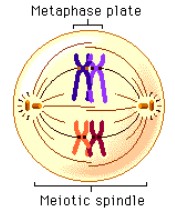
Anaphase I:
- Contraction of the spindle fibers pulls homologous chromosome pair apart.
- Chaismata breaks apart and separate.
- One chromosome of each pair move to opposite poles of the cell
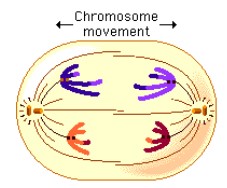
Telophase I:
- Chromosome begins to uncoil and nuclear envelop reforms.
- Chromosome number reduces from 2n (diploid) to n (haploid); however each
chromatid still has the replicated sister chromatid still attached (not homologous
pairs anymore). - Cytokinesis occurs and the cell splits into two separate cells.
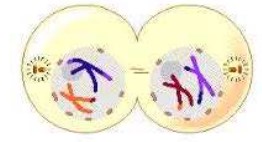
Prophase II:
- Chromosomes condense again and become visible.
- Spindle fibers again form.
- Nuclear membrane disintegrates again
Metaphase II
- Chromosomes line up along the equator.
- Spindle fibre attaches to the centromere of the chromosome
Anaphase II:
- Spindle fibers pull apart the centromeres and sister chromatids are pulled towards the opposite poles.
Telephase II:
- Chromosomes arrive at opposite poles.
- Nuclear envelope begins to develop around each of the four haploid cells.
- Chromosomes begin to unwind to form chromatin.
- Cytokinesis occurs and cells are split apart
Meiosis, or sex cell division
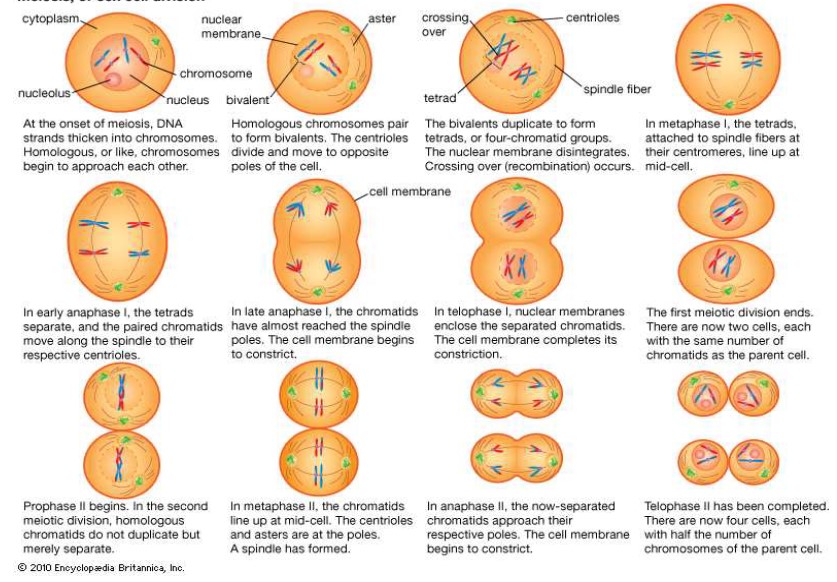
Genetic variation:
Crossing over:
- Occurs in prophase I of meiosis.
- Crossing over occurs between non-sister chromatids of a particular chromosome.
- Chiasmata are points where two homologous non-sister chromatids exchange genetic material during crossing over in meiosis.
- Chromosomes intertwine and break at the exact same positions in non-sister chromatids.
- Segments of the adjacent homologues are exchanged during crossing over, therefore the two sister chromatids are no longer identical.
- Crossing over creates new combinations of linked genes (genes on the same chromosome) from the mother and the father.
- When the chromatids are separated into different gametes after anaphase II, the gametes produced will not contain the same combination of alleles as the parental chromosomes.
- This creates variation in the offspring regardless of random orientation.
Random Orientation:
- Occurs in metaphase I of meiosis.
- When homologues line up along the equatorial plate in metaphase I, the orientation of each pair is random; meaning the maternal or paternal homologue can orient toward either pole.
- This means the number of combinations that can occur in the gamete is 2n(n=number of chromosome pairs).
- Therefore, in a female or male gamete there can be 223 or 8,388,608 different possible combinations.
- Now when you consider there is the same number of possible combinations in the other gamete that it will combine with to form a zygote (random fertilization); the genetic possibilities are staggering.
- If one takes into consideration crossing over, which was explained above, the genetic variation possibilities in the offspring is immeasurable
Non-disjunction:
- A non-disjunction is an error in meiosis, where the chromosome pairs fail to split during cell division.
- Non-disjunction can occur in anaphase I where the homologous pairs fail to split, or it can occur in anaphase II, where the sister
chromatids fail to split. - The result of this error is too many chromosomes in a gamete cell or too few chromosomes in the final gamete cell.
- One of the gamete cells could have 22 chromosomes and one could have 24 chromosomes. The resulting zygote will therefore have 47 or 45 chromosomes.
- An example of a non-disjunction is Down’s syndrome.
- Down syndrome occurs when chromosome 21 fails to separate, and one of the gametes ends up with an extra chromosome 21.
Therefore, a child that receives that gamete with an extra chromosome 21 will have 47 chromosomes in every cell. - Down syndrome is also called Trisomy 21.
- Some Down syndrome symptoms include impairment in cognitive ability and physical growth, hearing loss, oversized tongue, shorter limbs and social difficulties
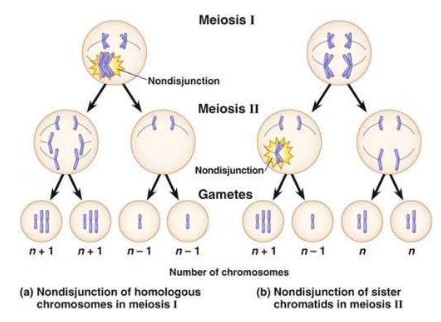
Karyogram:
- A diagram or photograph of the chromosomes present in a nucleus arranged in homologous pairs of descending length.
- It can be used to make diagnosis of non-disjunction genetic disorder, such as Down’s Syndrome.
- Amniocentesis: a sample of the amniotic fluid surrounding the baby is removed using a syringe.
- The sample contains skin cell from the baby, so we can use that to make a karyogram, in order to check for genetic disorder.
